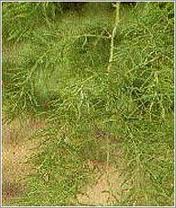| PlantID | 0064 |
| Botanical Name | Asparagus racemosus |
| Common Name | Satavari |
| Classification | | Kingdom: | Plantae | | Subkingdom: | Tracheobionta | | Division: | Magnoliophyta | | Class: | Magnoliopsida | | Subclass: | Magnoliidae | | Order: | Asparagales | | Family: | Liliaceae | | Genus: | Asparagus | | Species: | racemosus |
|
| Part used | Root |
| Medicinal Properties | Antidiarrhetic, Antispasmodic, aphrodisiac, antidysenteric, dernulcent, diuretic, galactagogue. |
| Medicinal Use | Used in stomach ache, diarrhea, inflammation, burning sensation, excessive perspiration, nervous debility, cough, bronchitis and skin diseases. Stimulate mammary gland secretion. Shatavari is considered to be the main Ayurvedic rejuvenating female tonic for overall health and vitality.
|
| Chemistry | Four saponins, viz. shatavarin I to IV. Shatavarin IV is a glycoside of sarsasapogenin having two molecules of rhamnose and one molecule of glucose. It also contains mucilage and starch. |
| Cultivation | NA |
| Regional Habitat | Found throughout Rajasthan. Areas upto 1400 m elevations. |
| Description | A thorny, climbing shrub with woody stems. Leaves are reduced to minute scales and spines.Fruits are globular, purplish black. Roots are succulent and tuberous which are tapering at both end. |
| Image |  |


